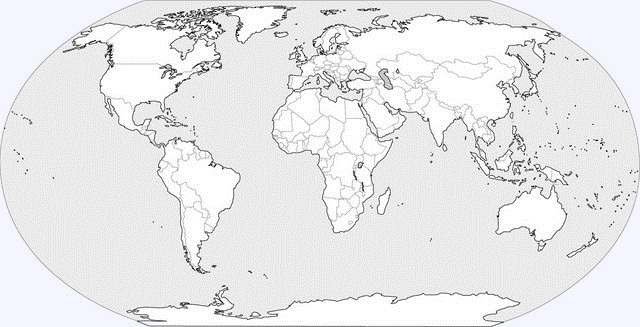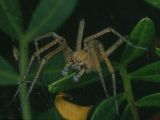|
Nombre común en ingles:
Minute clasping
weavers
Nombre común en castellano:
Se desconoce
Familias similares:
Género tipo:
Mysmena Simon, 1894
Diagnosis:
Very small araneomorph spiders;
three tarsal claw; ecribellate; entelegyne; eight eyes; male with
mating spine on metatarsus I (sometimes on tibia I as well); cymbium
of male palp with lobes or apophyses; female and sometimes males
with a sclerotized subdistal ventral spot on anterior femora.
Caracteres descriptivos:
Caparazón:
usually ligh, with highest point behind eyes, except in Isela and
Kilifina where carapace flattened. Esternón:
truncated, rarely pointed (Maymena), between coxae IV. Ojos:
eight; in two rows; anterior median eyes usually larger than other
eyes; lateral eyes contiguous, situated close to anterior median
eyes. Quelíceros: usually with tiny denticles scattered
between cheliceral teeth. Piezas bucales: labium rebordered. Patas:
three claws; male with mating spine on metatarsi I; femur I, and
sometimes II of female and sometimes male with sclerotized spot
ventro-subdistally; tarsi longer than or equal in lengh to
metatarsi; tarsi IV without serrated setae; tarsal organ capsulate. Palpo femenino:
not reduced but lacking a claw. Abdomen: soft; spherical to
hight than long; usually bearing scattered, long setae; scutum
sometimes present. Hileras:
anterior lateral spinnerets with reduced bases of piriform gland
spigots; posterior lateral spinnerets with triplet; colulus present. Sistema respiratorio:
booklungs usually absent. Genitalia: entelegyne; epigyne
usually with simple posterior plate or scapus; cymbium of male palp
with lobes or apophyses. Tamaño corporal:
<
3 mm. Color: varies from yellow-brown to grey, sometimes with
greenish tinge, abdomen dark grey with pale markings or white spots.
Estatus taxonómico:
After having been considered part of the Theridiidae, Mysmeninae was
for some time a subfamily of the Symphytognathidae. Forster &
Platnick (1977) accorded the taxon family rank. Coddington & Levi
(1991) placed the mysmenids in the Araneoidea and suggested that
they are part of the 'higher araneoids', as sister to
Symphytognathidae, in a group of families considered to be the
sister-group of the Araneidae. Griswold et al. (1998), followed by
Coddington et al. (2004). place the Mysmenidae within the so-called
Symphytognathoidea, sister to Anapidae + Symphytognathidae. Schütt
(2003) corroborates this placement but claims that the mysmenids
must be relimited and the Old World genera transferred to the new
family Synaphridae, in accordance with Wunderlich (1986).
Wunderlich's (2004) opinion that Anapidae should be widened to
include the Mysmenidae in only poorly founded by a 'possible'
cladogram.
Distribución: mundial.

Estilo de vida: Little is
known about the behaviour of mysmenids. Some species are
kleptoparasites on the webs of other spiders, whereas others spin
sheet webs in low vegetation. Mysmenidae usually inhabit crevices or
leaf litter in very humid habitats. Webs are known for a few species
and vary from a complex three-dimensional orb with a proliferation
of out-of-the-plane radii over a roughly egg-shapped space web to
some kind of sheetweb.
Bibliografía:
-
Dippenaar-Schoeman, A.S. & Jocqué,
R. 1997. African Spiders: An Identification Manual. Plant Protection
Res. Inst. Handbook, no. 9, Pretoria, 392 pp.
-
Forster, R.R. &
Platnick, N.I. 1977. A review of the spider family Symphytognathidae
(Arachnida, Araneae). Am. Mus. Novit. 2619: 1-29.
-
Gertsch, W.J. 1960.
Descriptions of American spiders of the family Symphytognathidae.
Am. Mus. Novit. 1981: 1-40.
-
Griswold, C.E.,
Coddington, J.A., Hormiga, G. & Scharff, N. 1998. Phylogeny of the
orb-web building spiders (Araneae, Orbiculariae: Deinopoidea,
Araneoidea). Zool. J. Linn. Soc. 123: 1-99.
-
Lopardo, L. &
Coddington, J.A. 2005. Mysmenidae. pp. 175-177 in Ubick, D., Paquin,
P., Cushing, P.E. & Roth, V. (Eds) 2005. The Spiders of North
America. An Identification Manual. American Arachnological Society.
-
Platnick, N.I. &
Shadab, M.U. 1978b. A review of the spider genus Mysmenopsis (Araneae,
Mysmenidae). Am. Mus. Novit. 2661: 1-22.
-
Schütt, K. 2003.
Phylogeny of Symphytognathidae s.l. (Araneae, Araneoidea). Zool.
Scripta 32: 129-151.
-
Wunderlich, J. 1986.
Spinnenfauna gestern und heute: Fossile Spinnen in Bernstein und
ihre heute lebenden Verwandten. Quelle & Meyer, Wiesbaden, 283 pp.
-
Wunderlich, J. 2004.
Fossil spiders in amber and copal. Joerg Wunderlich Verlag.
Hirschberg-Leutershausen (Germany). Vol. 3 A, B, 1908 pp.
1 género y 2 especies presentes en la Península Ibérica:
|
| |
- M. gibbosa
Snazell, 1986 |
| |
- M. leucoplagiata
(Simon, 1879) |
| |
|
 |